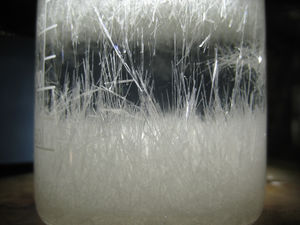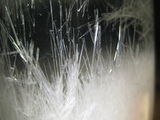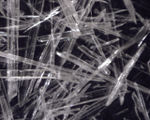Nitroguanidine
 Nitroguanidine crystallized from water
| |
| Names | |
|---|---|
| IUPAC name
1-Nitroguanidine
| |
| Other names
N-nitroguanidine
Nitro-guanidine NQ Picrite | |
| Properties | |
| CH4N4O2 | |
| Molar mass | 104.07 g/mol |
| Appearance | Colorless crystalline solid |
| Odor | Odorless |
| Density | 1.71 g/cm3 |
| Melting point | 232 °C (450 °F; 505 K) |
| Boiling point | 250 °C (482 °F; 523 K) (decomposes) |
| 0.271 g/100 ml (19.5 °C) 0.44 g/100 ml (25 °C) 1.181 g/100 ml (50 °C) 10.366 g/100 ml (100 °C)[1] | |
| Solubility | Slightly soluble in ethanol, methanol, conc. sulfuric acid Insoluble in diethyl ether |
| Solubility in methanol | 0.5% |
| Vapor pressure | 1.43·10-11 mmHg (25 °C) |
| Hazards | |
| Safety data sheet | Sigma-Aldrich |
| Lethal dose or concentration (LD, LC): | |
| LD50 (Median dose)
|
4.345 mg/kg (rat, female, oral) 5.620 mg/kg (rat, male, oral) |
| Related compounds | |
| Related compounds
|
Guanidine Guanidinium nitrate Nitrourea |
| Except where otherwise noted, data are given for materials in their standard state (at 25 °C [77 °F], 100 kPa). | |
| Infobox references | |
Nitroguanidine is an organic compound with the formula (NH2)2CNNO2 or CH4N4O2. It is mainly used used as a propellant (air bags) and sometimes as fertilizer, as well as a few other niche uses in chemistry and industry.
Contents
Properties
Chemical
Nitroguanidine decomposes when heated to release various gases:
- (NH2)2CNNO2 (s) → 2 H2O (g) + 2 N2 (g) + C (s)
Physical
Nitroguanidine is an odorless colorless solid, though impure samples may appear yellow. It is poorly soluble in water.
Explosive
Nitroguanidine is an energetic material, widely used as propellant. It has low impact sensitivity, but its detonation velocity is high.
Availability
Nitroguanidine is used as propellant in more recent models of air bags, replacing sodium azide, and sometimes as fertilizer. Some phosphate-based coatings also use nitroguanidine.
Preparation
Nitroguanidine can be prepared by dehydrating guanidinium nitrate with concentrated sulfuric acid or fuming nitric acid.[2]
- [C(NH2)3]NO3 → (NH2)2CNNO2 + H2O
Projects
- Propellant
- Smokeless powder
- Make Aminoguanidine
Handling
Safety
Nitroguanidine is an explosive material and should be handled with care.
Storage
It should be kept damp in closed bottles.
Disposal
Controlled incineration is a good option.
Can also be strongly dissolved in water and used as fertilizer.
Gallery
References
- ↑ Desvergnes; Rev.Chim.ind.; vol. 38; (1929); p. 266
- ↑ https://onlinelibrary.wiley.com/doi/abs/10.1002/14356007.a12_545.pub2

